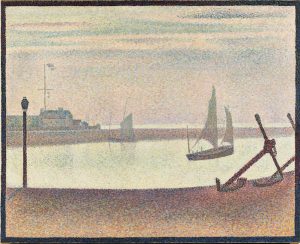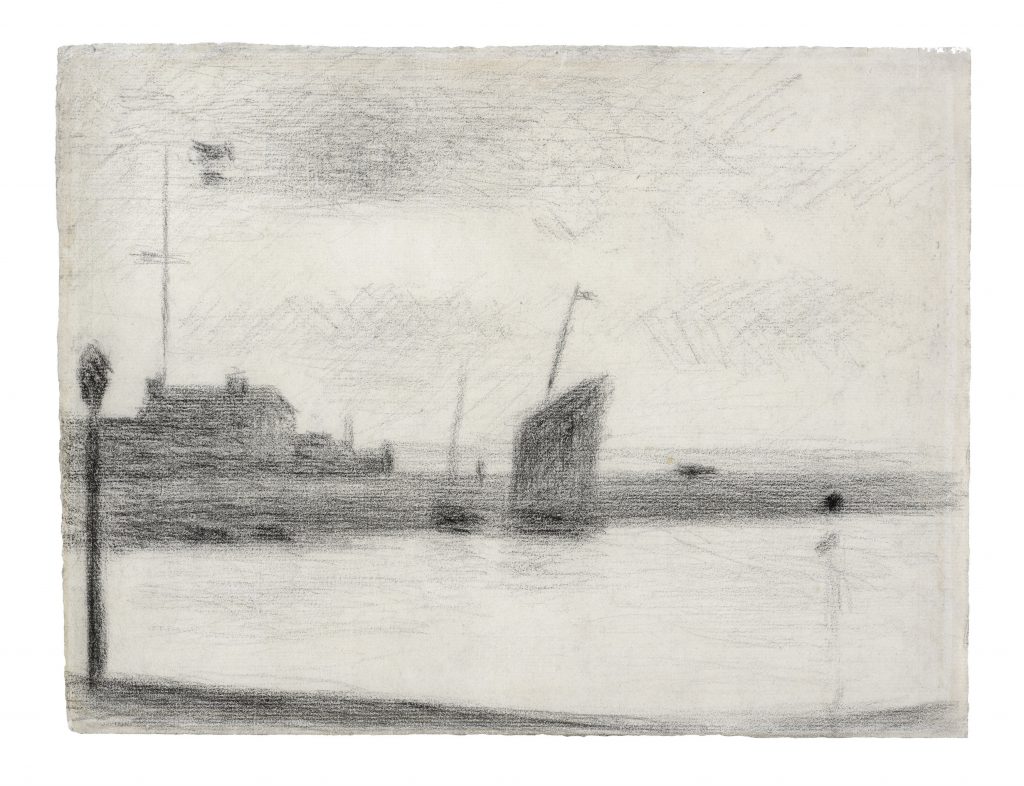Georges Seurat
(1859 - Paris - 1891)
Un Soir, Gravelines, 1890
Conté crayon on Michallet paper, 23.8 x 31.5 cm
Provenance:
Léon Appert (1837-1925), the artist's brother-in-law, Paris (probably until his death)
By descent to Mme Léon Roussel, Paris
Private collection, Paris
Paris, Ader Picard Tajan, auction sale, 22 June 1988, lot 3 (sold by the above)
André Blomberg, Paris (purchased at the above sale)
London, Sotheby’s, auction sale, 3 February 2010, lot 3
European private collection
Exhibited:
Seurat, Paris, Musée Jacquemart-André, November-December 1957, no. 44 (titled Port-en-Bessin)
Seurat at Gravelines: The Last Landscapes, Indianapolis, Indianapolis Museum of Art, 1990, no. 8 (titled Evening)
Georges Seurat 1859-1891, Paris, Galeries Nationales du Grand Palais, 9 April-12 August 1991, no. 222 and New York, The Metropolitan Museum of Art, 24September 1991-12 January 1992, no. 224, repr. (titled Un Soir, dessin pour 'Gravelines: un soir')
Literature:
Henri Dorra and John Rewald, Seurat, l'œuvre peint. Biographie et catalogue critique, Paris 1959, no. 202a, repr. p. 262 (titled Crépuscule, étude pour 'Gravelines, un soir’)
Joseph-Emile Muller, Seurat, dessins, Paris 1960, repr. p. 35 (titled Le Chenal de Gravelines)
César M. de Hauke, Seurat et son œuvre, Paris 1961, II, no. 696, repr. p. 289 (titled Un Soir, Port-en-Bessin)
Robert Herbert, Seurat's Drawings, New York, 1962, pl. CXXXV, repr. p. 155
André Chastel and Fiorella Minervino, Tout l'œuvre peint de Seurat, Paris 1973, no. D71, repr. p. 110 (titled Crépuscule, étude pour 'Gravelines, un soir')
Richard Thomson, Seurat, Oxford 1985, mentioned p. 173
Michael Zimmermann, Seurat and the Art Theory of his Time, Antwerp 1991, no. 590, repr. p. 439
This composition appears as the most satisfyingly complete of the Gravelines drawings. Its sky bears the delicate lines and rubbings of Seurat’s late drawings, which here seem appropriate to the pervasive light of the flattened-out Channel coast. (Robert Herbert)[1]
This fine drawing was made by Georges Seurat en plein air on the quay of Gravelines, a small French seaport near the Belgian border. It is a study for the painting titled Le Chennal de Gravelines: Evening, today in the collection of the Museum of Modern Art, New York (Fig. 1). Three other drawings and one oil sketch related to this painting are recorded, the present study being the closest to the final composition.
In her entry on the drawing in the catalogue of the 1991 Seurat exhibition at the Indianapolis Museum of Art, Ellen W. Lee writes: One of the conté crayon drawings prefigures the left half of the finished canvas, as it shows the addition of two boats, one with sail and one without. The cloudy sky is hastily sketched with hatchings in criss-cross and chevron patterns that bear no particular resemblance to the striated sky of the canvas. While the Gravelines drawings are not characterized by the rich blacks and the sense of contrast that distinguish Seurat’s most evocative independent works on paper, this drawing does reveal his attention to tonal distinctions. The lamppost is the darkest element of the drawing, a role it maintains in the finished canvas. A curious element on the right side of the drawing is the subtle band of vertical lines that descends from a dark spot just below the far shore. It suggests that the artist was assessing the effect of a vertical addition to this area.[2]

Fig. 1 Georges Seurat, Channel at Gravelines: Evening, 1890, oil on canvas, 65.4 x 81.9 cm, The Museum of Modern Art, New York, Gift of Mr. And Mrs.
William A.M. Burden. inv. 785.1963.a-b©2018. Digital image, The Museum of
Modern Art, New York/Scala, Florence
Gravelines harbor, situated on the river Aa, connects to the open sea via a narrow channel. In the seventeenth century, King Philip IV of Spain had two small fortifications constructed on either side of this channel. They were soon surrounded by small hamlets, Grand Fort Philippe on the west and Petit Fort Philippe on the east. Seurat made the drawing from a vantage point in Petit Fort Philippe looking across the channel towards a few outlying houses at Grand Fort and the open sea in the distance. He drew his inspiration from the alternating planes of land and water merging in the dusk. The absence of staffage reveals his intention to avoid anecdotal distraction and focus on the atmosphere and the light conditions.[3]
Seurat spent the summer of 1890 at Gravelines. The preliminary drawings and four paintings of the channel that he produced here were to be his last landscapes. They were shown at the exhibition of Les XX in Brussels in February 1891 and at the Salon des Indépendants in Paris in March 1891. The paintings were still on view when Seurat died, at the age of only thirty-one, on 30 March 1891.[4] After his early death this drawing passed into the hands of his brother-in-law, Léon Appert.
[1] Georges Seurat 1859-1891, exhib. cat., Paris, Galeries Nationales du Grand Palais, 9 April-12 August 1991, New York and The Metropolitan Museum of Art, 24 September 1991-12 January 1992, p. 357.
[2] Seurat at Gravelines: The Last Landscapes, exhib. cat., Indianapolis, Indianapolis Museum of Art, 1990, p. 40.
[3] Ibid. pp. 25-8.
[4] Loc. cit.

